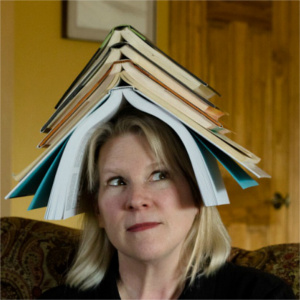“What children need is not new and better curricula but access to more and more of the real world; plenty of time and space to think over their experiences, and to use fantasy and play to make meaning out of them; and advice, road maps, guidebooks, to make it easier for them to get where they want to go (not where we think they ought to go), and to find out what they want to find out.” –John Holt
Miss Gribbon set up a new teaching prop at the front of our first grade classroom — three stick figures made of metal with round blank faces and oversized magnetic hands. Each figure was about the size of a toddler, although she referred to them as “men.” She said the first figure’s name was Ones. The next, to our right, she named Tens. The last in the row she named Hundreds. She added two bright red magnetic fingers to each figures’ hands. Then she announced that One’s fingers were worth two, Ten’s were worth 20, and Hundred’s were worth 200.
I could NOT understand how identical magnetic people could have fingers worth different amounts. The hundreds man wasn’t taller than the tens man or the ones man. Their fingers were the same size. So I watched carefully as she stood them up the next day, hoping to figure out what distinguished them. Nothing. Yesterday’s Ones man might be today’s Hundreds man. Their value wasn’t intrinsic to who they were. I struggled mightily to understand how one man could be worth more than another. (Story of my political confusion, even now.)
Each time Miss Gribbon rearranged the characters’ fingers she asked a different student, “What number do you see?” If they got it wrong, she asked again in a louder voice before reluctantly providing the answer. To me, math lessons seemed very similar to playing an unfamiliar game with kids who owned the game. They’d always say, “You’ll figure out the rules as we play.” By the time I did, they always won.

We start out in life equipped to pick up mathematical concepts easily. Well-designed studies reveal even babies demonstrate strong understanding of certain mathematical principles.
We continue to advance in our comprehension almost entirely through hands-on experience. Math is implicit in play, music, art, dancing, make-believe, building and taking apart, cooking, and other everyday activities. Only after a child has a strong storehouse of direct experience, which includes the ability to visualize, can he or she readily grasp more abstract mathematical concepts. As Einstein said, “If I can’t picture it, I can’t understand it.”
Yet right around the time formal instruction starts, children increasingly report that they worry about and fear math. Math anxiety, even in first and second graders, disproportionally affects children who have the most working memory. These are the very children most likely to show the highest achievement in math. But stress can disrupt working memory and undermine performance. Otherwise successful children with high degrees of math anxiety fall about half a school year behind less anxious students. In a study of 154 young students, about half had medium to high math anxiety.
Early math anxiety can intensify, leading to increased math avoidance and lowered competence. Over 60 years of research show that positive attitudes toward math tend to deteriorate as students move through school. More than half the adult population in the U.S. is said to suffer from math anxiety, some with math avoidance so extreme that it has the potential to damage financial decisions and careers.
Is math instruction to blame?
Innovative math educator Maria Droujkova says, in an Atlantic article titled “5-Year-Olds Can Learn Calculus,” that math instruction typically follows a hierarchical progression starting with counting, then addition and subtraction, then multiplication and division, onward to fractions, algebra, and so on. Unfortunately, she says, this approach has “... nothing to do with how people think, how children grow and learn, or how mathematics is built.” She and other math educators around the world say the standard curriculum that begins with arithmetic is actually more difficult for children than play-based activities related to more advanced fields of mathematics. As Dr.Droujkova writes, “Calculations kids are forced to do are often so developmentally inappropriate, the experience amounts to torture.”
That torture is compounded by the way math is taught. Extensive research demonstrates that kids readily understand math when they develop the ability to use numbers flexibly, what’s called a “number sense.” Number sense is fundamental to all higher-level mathematics. This does not develop through memorization but instead from relaxed, enjoyable exploratory work with math concepts. In fact, math experts repeatedly point out that math education standbys — flash cards, repetitive worksheets, and timed tests — are not only unhelpful but actually damaging. These common methods discourage number sense, setting young people off in the wrong direction. In fact doing math under pressure impairs the working memory students need to access what they already know. Pressure also leads to math anxiety. There’s no educational reason to use these tactics in the classroom or at home. Greater math ability has nothing to do with working quickly nor does quick recall of math facts relate to fluency with numbers.
Add to this the burden of grades and test scores. Students today deal with a heavy load of standardized tests across all major subjects, plus tests in math class as often as every few days. They quickly learn math has to do with performance, not with usefulness and certainly not with beauty or mystery.
As mathematics educator Jo Boaler writes in Mathematical Mindsets, it’s well known that grades and test scores damage motivation and result in limiting self-labels in high, middle, and low-achieving students. Research consistently shows that alternatives to grading are far more beneficial. One study compared the way teachers responded to math homework in sixth grade. Half the students were graded, the other half were given diagnostic comments without a grade. Students who got only comments learned twice as fast as the graded group, attitudes improved, and any achievement gap between male and female students disappeared.
Dr. Boaler writes about another study in which fifth and sixth grade students were assessed three different ways. Some students received only grades, some only comments, and some both grades and comments. The students who achieved at significantly higher levels were those who were given comments only. Those who got any grade at all, with or without comments, did poorly. This was true for students across the spectrum of ability. Further research found that students only needed to believe they were being graded to lose motivation and achieve less.
Studies continue to show that students given positive feedback and no grades are more successful as they continue through school. There’s a strong relationship between teachers’ assessment practices and students’ attitude about their own potential. Unfortunately teachers give less constructive feedback as students get older and students’ belief in their own chance of improving also declines steadily from upper elementary grades through high school.
What happens when students aren’t assessed?
Dr. Boaler followed teenagers in England who worked on open-ended math projects for three years. These students were not graded or tested, and only given information about their own learning, even though they faced national standardized tests at the end of that period. A few weeks before the test they were given practice exams to work through. Although they were largely unfamiliar with exam questions or timed conditions, when tested these students scored at a significantly higher level than students who had gone through standard math classes with frequent tests similar to the national exam questions.
What happens when math instruction is even more limited?
Back in 1929, pioneering educator Louis P. Benezet, superintendent of the Manchester, New Hampshire schools, wrote, “The whole subject of arithmetic could be postponed until the seventh year of school, and it could be mastered in two years’ study by any normal child.” He began an experiment. In five classrooms, children were exposed only to naturally occurring math like telling time and playing games, while in other classrooms children received typical math lessons.
At the end of the first year differences were already apparent between students exposed to these two different approaches. When children were asked the same mathematical story problem, the traditionally taught students grabbed at numbers but came up with few correct results, while the experimental students reasoned out correct answers eagerly, despite having minimal exposure to formal math. Based on these successes, the experiment expanded. By 1932, half of the third- to fifth-grade classes in the city operated under the experimental program. After several years, the experiment ended due to pressure from some principals. Children in the experimental classrooms went back to learning from a math book in the second half of sixth grade. All sixth-grade children in the district were tested and in the spring of that year all the classes tested equally. When the final tests were given at the end of the school year, one of the experimental groups led the city. In other words, those children exposed to traditional math curricula for only part of the sixth-grade year had mastered the same skills as those who had spent years on drills, times tables, and exams. Even more remarkably, the students in the experimental classrooms were from the most poverty-stricken neighborhoods where poor school performance was common. The Journal of the National Education Association published the last of Mr.Benezet’s articles in 1936, calling on educators to replace formal math instruction with naturally occurring math.
What happens when there’s no math instruction by trained educators?
Homeschooling and unschooling families around the world devote much less, if any, time to formal mathematics instruction. There are significant limitations to research of homeschooled and unschooled youth for a variety of reasons, including a self-selecting population, so findings are interesting but inconclusive.
Multiple studies indicate homeschooling offers significant academic advantages, regardless of the parent’s educational attainment. Those tested in the last two years of homeschooling, what would be a schooled student’s junior and senior years, statistically score in the 86th to 92nd percentile. The percentage of homeschooled students who complete college far exceeds the rate of public school students.
Studies show homeschoolers taking the SAT tend to score significantly above average in all areas except math where their scores are still above average. The most recent College Board stats show mean scores for all college-bound seniors were 497 in critical reading, 487 in writing, and 513 in mathematics. For the 13,549 homeschooled seniors who took the test that year, means scores were 567 in critical reading, 535 in writing, and 521 in mathematics.
It’s hard to wade through research comparing math achievement of homeschooled versus conventionally schooled young people because much of the research includes as “homeschooled” those students who are educated using district or state sponsored programs which provide conventional-style math instruction to be done at home, which largely replicates the problems of conventional classroom instruction.
Still, several informal surveys show disproportionate number of homeschool and unschool adults working in STEM careers. And it seems that a significant number of today’s high-achievers in technology, science, and math have emerged from the homeschooling community. Their numbers include:
- Erik Demain — professor of theoretical computer science at MIT and named “one of the most brilliant scientists in America” by Popular Science
- Ruth Elke Lawrence-Naimark — researcher in knot theory and algebraic topology,
- Francis Collins — geneticist and director of the National Institutes of Health, Samuel Chao Chung Ting — physicist and Nobel Prize recipient,
- Phillip Streich — holder of numerous patents and co-founder of nanotechnology company making him a multimillionaire by the time he entered Harvard,
- Arran Fernandez — youngest mathematician with sequences published in Encyclopedia of Integer Sequences,
- Willard Boyle — physicist, co-inventor of charge-coupled device and Nobel Prize winner.
What happens when there’s no math instruction other than what young people request?
Democratic schools exist at the opposite end of the spectrum from conventional schooling. Students are not segregated by age and each student has one vote, just as staff members do, to democratically run the community. All young people are trusted to choose their own activities and no classes are mandatory, making these schools a collectively managed and open setting for self-directed learning.
Psychologist Peter Gray surveyed graduates of one such school, Sudbury Valley School (SVS) in Framingham Massachusetts. He found that young people who were not mandated to follow curricula, take tests, and receive grades “...have gone on to good colleges and good jobs...They are taking responsible positions in business, music and art, science and technology, social services, skilled crafts, and academia.” Dr. Gray notes that employers are rarely concerned about a prospective employee’s grades in algebra. Instead the traits for career success are those that graduates say were fostered by their time at SVS, such as “...a strong sense of responsibility, an ability to take initiative and solve problems, a desire and ability to learn on the job, an ability to communicate effectively, and perhaps most of all, a high interest in and commitment to the field..”
And there’s this anecdote, shared by teacher Daniel Greenberg in his book Free At Last. A group of students at the Sudbury Valley School approached him saying they wanted to learn arithmetic. He tried to dissuade them, explaining that they’d need to meet regularly and do homework. The students agreed to do so. In the school library, Greenberg found a math book written in 1898 that was perfect in its simplicity. Memorization, exercises, and quizzes were not ordinarily part of the school day for these students, but they arrived on time, did their homework, and took part eagerly. Greenberg reflects, “In twenty weeks, after twenty contact hours, they had covered it all. Six year’s worth. Every one of them knew the material cold.” A week later he described what he regarded as a miracle to a friend, Alan White, who worked as a math specialist in public schools. White wasn’t surprised. He said, “...everyone knows that the subject matter itself isn’t that hard. What’s hard, virtually impossible, is beating it into the heads of youngsters who hate every step. The only way we have a ghost of a chance is to hammer away at the stuff bit by bit every day for years. Even then it does not work. Most of the sixth graders are mathematical illiterates. Give me a kid who wants to learn the stuff — well, twenty hours or so makes sense.”
These examples aren’t meant to be anti-teaching, they are meant to broaden our understanding about when instruction is most useful and effective. That happens less often than we’d think — when the learner seeks guidance, demonstration, resources, or help. Learning that’s sought out sticks with the learner. It promotes curiosity, persistence, passion, and deep inquiry — exactly what’s needed to dig into the fathomless depths of mathematics or any other pursuit.

Math as it’s used by the vast majority of people around the world is actually applied math. It’s directly related to how we work and play in our everyday lives. In other words it’s useful, captivating, and often fun.
Interestingly, people who rely on mental computation every day demonstrate the sort of adroitness that doesn’t fit into conventional models of math competence. In a New York Times article titled “Why Do Americans Stink at Math,” author Elizabeth Green (who defines the term “unschooled” as people who have little formal education) writes,
Observing workers at a Baltimore dairy factory in the ’80s, the psychologist Sylvia Scribner noted that even basic tasks required an extensive amount of math. For instance, many of the workers charged with loading quarts and gallons of milk into crates had no more than a sixth-grade education. But they were able to do math, in order to assemble their loads efficiently, that was “equivalent to shifting between different base systems of numbers.” Throughout these mental calculations, errors were “virtually nonexistent.” And yet when these workers were out sick and the dairy’s better-educated office workers filled in for them, productivity declined.
The unschooled may have been more capable of complex math than people who were specifically taught it, but in the context of school, they were stymied by math they already knew. Studies of children in Brazil, who helped support their families by roaming the streets selling roasted peanuts and coconuts, showed that the children routinely solved complex problems in their heads to calculate a bill or make change. When cognitive scientists presented the children with the very same problem, however, this time with pen and paper, they stumbled. A 12-year-old boy who accurately computed the price of four coconuts at 35 cruzeiros each was later given the problem on paper. Incorrectly using the multiplication method he was taught in school, he came up with the wrong answer. Similarly, when Scribner gave her dairy workers tests using the language of math class, their scores averaged around 64 percent. The cognitive-science research suggested a startling cause of Americans’ innumeracy: school.
And Stanford mathematician Keith Devlin explains in The Math Gene that we’re schooled to express math in formal terms, but that’s not necessary for most of us — no matter what careers we choose. People who rely on mental math in their everyday lives are shown to have an accuracy rate around 98 percent, yet when they’re challenged to do the same math symbolically (as in standardized tests) their performance is closer to 37 percent.
Conventional math education may also limit our concept of what math can do. As Dr. Devlin notes in a post titled “Most Math Problems Do Not Have a Unique Right Answer:”
One of the most widely held misconceptions about mathematics is that a math problem has a unique correct answer...
Having earned my living as a mathematician for over 40 years, I can assure you that the belief is false. In addition to my university research, I have done mathematical work for the U. S. Intelligence Community, the U.S. Army, private defense contractors, and a number of for-profit companies. In not one of those projects was I paid to find ‘the right answer.’ No one thought for one moment that there could be such a thing.
So what is the origin of those false beliefs? It’s hardly a mystery. People form that misconception because of their experience at school. In school mathematics, students are only exposed to problems that (a) are well defined, (b) have a unique correct answer, and (c) whose answer can be obtained with a few lines of calculation.

How can we translate all these findings into math education? We not only need to drop flashcards, timed tests, and rote worksheets. We need to emphasize math as meaningful, useful, and connected.
- The most statistically significant predictors of long-term math achievement, according to a study that tracked children from age three to age 10, had very little to do with instruction. Instead the top factors were the mother’s own educational achievements and a high quality home learning environment. That sort of home environment included activities like being read to, going to the library, playing with numbers, painting and drawing, learning letters and numbers, singing and chanting rhymes. These positive effects were as significant for low-income children as they were for high income children. Children who attended highly effective preschools (but not moderately effective programs) also benefited. Understanding numbers as meaningful and fun is important from the earliest years.
- Technology innovator Conrad Wolfram says we need to go beyond computation. He suggests these four steps:
- Pose the right question about an issue
- Change that real world scenario into a math formulation
- Compute
- Turn the math formulation back into a real world scenario to verify it
- Barnard College president Sian Beilock president says math is best learned as storytelling and done so by incorporating the body, the way children naturally absorb real world math. As neuroscientists map the brain, they find humanity evolved skills that overlaid onto areas of the brain that control the body. Math doesn’t sink in when confined to the intellect. It is drawn in through the body. We see this in studies showing babies who are able to move and explore more freely learn more quickly. “Math, Dr. Beilock says, “is a very recent cultural invention.” The part of the brain used for numerical representation is related to finger motion, demonstrating exactly why children best learn by counting on their fingers. Hand movement all the way up to full body engagement, such as walking while thinking, are actually more valuable than speech in comprehending everything from early computation to abstract concepts in physics. Dr. Beilock also emphasizes the benefits of time in nature to refresh one’s attention, leading to greater focus and comprehension.
- Dr. Droujkova adds to this by emphasizing richly social math experiences that are both complex (able to go in a variety of directions) and simple (open to immediate play). She says any branch of mathematics offers both complex and simple ways in. It is best, she explains, to keep from chaining kids into formal equations early on. There’s an informal level where kids play with ideas and notice patterns. Then comes a more formal level where kids can use abstract words, graphs, and formulas. But it’s best if a playful attitude is kept alive, because what mathematicians do at the highest level is play with abstract ideas. Dr. Droujkova notes that the community she founded called Natural Math is essentially a “freedom movement.” She explains: “We work toward freedom at many levels — the free play of little kids, the agency of families and local groups in organizing math activities, the autonomy of artists and makers, and even liberty for us curriculum designers. ... No single piece of mathematics is right for everyone. People are different, and people need to approach mathematics differently.”
Although we’ve been schooled to believe that math must be taught in a structured way by professionals, Dr. Droujkova continues to establish lively and engaging community-based, open-learning math circles that can be led by any adult. She and her colleagues make their materials open under Creative Commons license and offer online hubs with courses and resources for parents, teachers and teenagers who want to lead local groups. (See naturalmath.com) As Dr. Droujkova says in a recent interview, “math circles are magic circles.”

School-like instruction has been around less than a fraction of one percent of the time we humans have been on earth. Yet humanity has thrived. That’s because we evolved as free range learners gaining mastery as we explore, play, emulate role models, challenge ourselves, make mistakes and try again. That’s how everyone learns to walk and talk. That’s how young people have become capable adults throughout history. And that’s how innovation happens in the arts, sciences, and technology. In the long view, school is the experiment.
For many it’s hard to see beyond the school mindset because most of us went to school. So when we think of education, we view school as the standard even if we simultaneously realize that many parts of that model (also found in daycare, preschool, kids’ clubs, sports, and enrichment programs) aren’t necessarily beneficial. Narrowing the innate way we learn can unintentionally narrow enthusiasm, creativity, persistence, and the desire to dive deeply into any pursuit. It can interfere with the full development of our abilities.
My first grade math lessons taught me to equate math with fear. I went on to get good grades in the subject, but by high school my math anxiety led me to give up hopes of working in a science field. Math misery doesn’t have to be imposed on the next generation.
It’s time to free ourselves from the assumption that math instruction is a painful necessity. Approaching math in ways that are disconnected from a child’s life subtracts the meaning and the joy. It multiplies fear. Data shows and experience proves that real learning flows from the learner’s consent and the learner’s interest. We can offer math as an enlivening, beautiful tool to the next generation as soon as we free ourselves from the limitations of the school mindset.
If you enjoyed this article and feel called to give back to ASDE, here are ways you can support our work:
- Donate money
- Share our content with others! Click one of the buttons above to easily share on Twitter, Facebook, or email.
- Consider becoming a Contributor for Tipping Points
Tipping Points Magazine amplifies the diverse voices within the Self-Directed Education movement. The views expressed in our content belong solely to the author(s). The Alliance for Self-Directed Education disclaims responsibility for any interpretation or application of the information provided. Engage in dialogue by reaching out to the author(s) directly.






